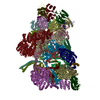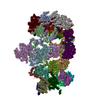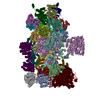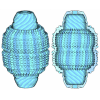+ Open data
Open data
- Basic information
Basic information
| Entry | Database: EMDB / ID: EMD-3913 | |||||||||||||||
|---|---|---|---|---|---|---|---|---|---|---|---|---|---|---|---|---|
| Title | Ground state 26S proteasome (GS2) | |||||||||||||||
 Map data Map data | ||||||||||||||||
 Sample Sample |
| |||||||||||||||
 Keywords Keywords | UPS / Ground state / Neuron degeneration / HYDROLASE | |||||||||||||||
| Function / homology |  Function and homology information Function and homology informationDegradation of CRY and PER proteins / Cross-presentation of soluble exogenous antigens (endosomes) / Proteasome assembly / N-glycan trimming in the ER and Calnexin/Calreticulin cycle / Regulation of ornithine decarboxylase (ODC) / Metalloprotease DUBs / Oxygen-dependent proline hydroxylation of Hypoxia-inducible Factor Alpha / Autodegradation of Cdh1 by Cdh1:APC/C / SCF-beta-TrCP mediated degradation of Emi1 / APC/C:Cdc20 mediated degradation of Securin ...Degradation of CRY and PER proteins / Cross-presentation of soluble exogenous antigens (endosomes) / Proteasome assembly / N-glycan trimming in the ER and Calnexin/Calreticulin cycle / Regulation of ornithine decarboxylase (ODC) / Metalloprotease DUBs / Oxygen-dependent proline hydroxylation of Hypoxia-inducible Factor Alpha / Autodegradation of Cdh1 by Cdh1:APC/C / SCF-beta-TrCP mediated degradation of Emi1 / APC/C:Cdc20 mediated degradation of Securin / APC/C:Cdh1 mediated degradation of Cdc20 and other APC/C:Cdh1 targeted proteins in late mitosis/early G1 / Cdc20:Phospho-APC/C mediated degradation of Cyclin A / SCF(Skp2)-mediated degradation of p27/p21 / Autodegradation of the E3 ubiquitin ligase COP1 / Asymmetric localization of PCP proteins / Degradation of DVL / Hedgehog ligand biogenesis / Dectin-1 mediated noncanonical NF-kB signaling / Degradation of GLI1 by the proteasome / Hedgehog 'on' state / TNFR2 non-canonical NF-kB pathway / NIK-->noncanonical NF-kB signaling / Assembly of the pre-replicative complex / CDK-mediated phosphorylation and removal of Cdc6 / G2/M Checkpoints / Ubiquitin-Mediated Degradation of Phosphorylated Cdc25A / Ubiquitin-dependent degradation of Cyclin D / The role of GTSE1 in G2/M progression after G2 checkpoint / FBXL7 down-regulates AURKA during mitotic entry and in early mitosis / RUNX1 regulates transcription of genes involved in differentiation of HSCs / Regulation of RUNX3 expression and activity / GSK3B and BTRC:CUL1-mediated-degradation of NFE2L2 / GLI3 is processed to GLI3R by the proteasome / Activation of NF-kappaB in B cells / Degradation of beta-catenin by the destruction complex / Degradation of AXIN / UCH proteinases / Regulation of RAS by GAPs / Orc1 removal from chromatin / Neddylation / AUF1 (hnRNP D0) binds and destabilizes mRNA / MAPK6/MAPK4 signaling / Regulation of PTEN stability and activity / KEAP1-NFE2L2 pathway / Separation of Sister Chromatids / fluid transport / Antigen processing: Ubiquitination & Proteasome degradation / ABC-family proteins mediated transport / Ub-specific processing proteases / thyrotropin-releasing hormone receptor binding / nuclear proteasome complex / host-mediated perturbation of viral transcription / positive regulation of inclusion body assembly / integrator complex / proteasome accessory complex / meiosis I / proteasome regulatory particle / cytosolic proteasome complex / proteasome-activating activity / proteasome regulatory particle, lid subcomplex / proteasome regulatory particle, base subcomplex / protein K63-linked deubiquitination / metal-dependent deubiquitinase activity / proteasome core complex / Neutrophil degranulation / proteasome binding / regulation of protein catabolic process / myofibril / proteasome storage granule / general transcription initiation factor binding / blastocyst development / immune system process / NF-kappaB binding / proteasome endopeptidase complex / proteasome core complex, beta-subunit complex / endopeptidase activator activity / proteasome assembly / threonine-type endopeptidase activity / mRNA export from nucleus / proteasome core complex, alpha-subunit complex / enzyme regulator activity / regulation of proteasomal protein catabolic process / inclusion body / proteasome complex / TBP-class protein binding / proteolysis involved in protein catabolic process / sarcomere / stem cell differentiation / negative regulation of inflammatory response to antigenic stimulus / P-body / lipopolysaccharide binding / double-strand break repair via homologous recombination / double-strand break repair via nonhomologous end joining / response to virus / nuclear matrix / metallopeptidase activity / peptidase activity / response to oxidative stress / cytoplasmic vesicle / response to ethanol Similarity search - Function | |||||||||||||||
| Biological species |  | |||||||||||||||
| Method | subtomogram averaging / cryo EM / Resolution: 12.3 Å | |||||||||||||||
 Authors Authors | Guo Q / Lehmer C | |||||||||||||||
| Funding support |  Germany, Germany,  United States, 4 items United States, 4 items
| |||||||||||||||
 Citation Citation |  Journal: Cell / Year: 2018 Journal: Cell / Year: 2018Title: In Situ Structure of Neuronal C9orf72 Poly-GA Aggregates Reveals Proteasome Recruitment. Authors: Qiang Guo / Carina Lehmer / Antonio Martínez-Sánchez / Till Rudack / Florian Beck / Hannelore Hartmann / Manuela Pérez-Berlanga / Frédéric Frottin / Mark S Hipp / F Ulrich Hartl / ...Authors: Qiang Guo / Carina Lehmer / Antonio Martínez-Sánchez / Till Rudack / Florian Beck / Hannelore Hartmann / Manuela Pérez-Berlanga / Frédéric Frottin / Mark S Hipp / F Ulrich Hartl / Dieter Edbauer / Wolfgang Baumeister / Rubén Fernández-Busnadiego /   Abstract: Protein aggregation and dysfunction of the ubiquitin-proteasome system are hallmarks of many neurodegenerative diseases. Here, we address the elusive link between these phenomena by employing cryo- ...Protein aggregation and dysfunction of the ubiquitin-proteasome system are hallmarks of many neurodegenerative diseases. Here, we address the elusive link between these phenomena by employing cryo-electron tomography to dissect the molecular architecture of protein aggregates within intact neurons at high resolution. We focus on the poly-Gly-Ala (poly-GA) aggregates resulting from aberrant translation of an expanded GGGGCC repeat in C9orf72, the most common genetic cause of amyotrophic lateral sclerosis and frontotemporal dementia. We find that poly-GA aggregates consist of densely packed twisted ribbons that recruit numerous 26S proteasome complexes, while other macromolecules are largely excluded. Proximity to poly-GA ribbons stabilizes a transient substrate-processing conformation of the 26S proteasome, suggesting stalled degradation. Thus, poly-GA aggregates may compromise neuronal proteostasis by driving the accumulation and functional impairment of a large fraction of cellular proteasomes. | |||||||||||||||
| History |
|
- Structure visualization
Structure visualization
| Movie |
 Movie viewer Movie viewer |
|---|---|
| Structure viewer | EM map:  SurfView SurfView Molmil Molmil Jmol/JSmol Jmol/JSmol |
| Supplemental images |
- Downloads & links
Downloads & links
-EMDB archive
| Map data |  emd_3913.map.gz emd_3913.map.gz | 2.5 MB |  EMDB map data format EMDB map data format | |
|---|---|---|---|---|
| Header (meta data) |  emd-3913-v30.xml emd-3913-v30.xml emd-3913.xml emd-3913.xml | 51.9 KB 51.9 KB | Display Display |  EMDB header EMDB header |
| Images |  emd_3913.png emd_3913.png | 53.1 KB | ||
| Filedesc metadata |  emd-3913.cif.gz emd-3913.cif.gz | 14 KB | ||
| Archive directory |  http://ftp.pdbj.org/pub/emdb/structures/EMD-3913 http://ftp.pdbj.org/pub/emdb/structures/EMD-3913 ftp://ftp.pdbj.org/pub/emdb/structures/EMD-3913 ftp://ftp.pdbj.org/pub/emdb/structures/EMD-3913 | HTTPS FTP |
-Validation report
| Summary document |  emd_3913_validation.pdf.gz emd_3913_validation.pdf.gz | 236.7 KB | Display |  EMDB validaton report EMDB validaton report |
|---|---|---|---|---|
| Full document |  emd_3913_full_validation.pdf.gz emd_3913_full_validation.pdf.gz | 235.8 KB | Display | |
| Data in XML |  emd_3913_validation.xml.gz emd_3913_validation.xml.gz | 5.2 KB | Display | |
| Arichive directory |  https://ftp.pdbj.org/pub/emdb/validation_reports/EMD-3913 https://ftp.pdbj.org/pub/emdb/validation_reports/EMD-3913 ftp://ftp.pdbj.org/pub/emdb/validation_reports/EMD-3913 ftp://ftp.pdbj.org/pub/emdb/validation_reports/EMD-3913 | HTTPS FTP |
-Related structure data
| Related structure data |  6epcMC  3914C  3915C  3916C  3917C  4191C  6epdC  6epeC  6epfC M: atomic model generated by this map C: citing same article ( |
|---|---|
| Similar structure data |
- Links
Links
| EMDB pages |  EMDB (EBI/PDBe) / EMDB (EBI/PDBe) /  EMDataResource EMDataResource |
|---|---|
| Related items in Molecule of the Month |
- Map
Map
| File |  Download / File: emd_3913.map.gz / Format: CCP4 / Size: 2.8 MB / Type: IMAGE STORED AS FLOATING POINT NUMBER (4 BYTES) Download / File: emd_3913.map.gz / Format: CCP4 / Size: 2.8 MB / Type: IMAGE STORED AS FLOATING POINT NUMBER (4 BYTES) | ||||||||||||||||||||||||||||||||||||||||||||||||||||||||||||||||||||
|---|---|---|---|---|---|---|---|---|---|---|---|---|---|---|---|---|---|---|---|---|---|---|---|---|---|---|---|---|---|---|---|---|---|---|---|---|---|---|---|---|---|---|---|---|---|---|---|---|---|---|---|---|---|---|---|---|---|---|---|---|---|---|---|---|---|---|---|---|---|
| Projections & slices | Image control
Images are generated by Spider. | ||||||||||||||||||||||||||||||||||||||||||||||||||||||||||||||||||||
| Voxel size | X=Y=Z: 3.42 Å | ||||||||||||||||||||||||||||||||||||||||||||||||||||||||||||||||||||
| Density |
| ||||||||||||||||||||||||||||||||||||||||||||||||||||||||||||||||||||
| Symmetry | Space group: 1 | ||||||||||||||||||||||||||||||||||||||||||||||||||||||||||||||||||||
| Details | EMDB XML:
CCP4 map header:
| ||||||||||||||||||||||||||||||||||||||||||||||||||||||||||||||||||||
-Supplemental data
- Sample components
Sample components
+Entire : Ground state 26S proteasome (GS2)
+Supramolecule #1: Ground state 26S proteasome (GS2)
+Macromolecule #1: Proteasome subunit alpha type-6
+Macromolecule #2: Proteasome subunit alpha type-2
+Macromolecule #3: Proteasome subunit alpha type-4
+Macromolecule #4: Proteasome subunit alpha type-7
+Macromolecule #5: Proteasome subunit alpha type-5
+Macromolecule #6: Proteasome subunit alpha type-1
+Macromolecule #7: Proteasome subunit alpha type-3
+Macromolecule #8: Proteasome subunit beta type-6
+Macromolecule #9: Proteasome subunit beta type-7
+Macromolecule #10: Proteasome subunit beta type-3
+Macromolecule #11: Proteasome subunit beta type-2
+Macromolecule #12: Proteasome subunit beta type-5
+Macromolecule #13: Proteasome subunit beta type-1
+Macromolecule #14: Proteasome subunit beta type-4
+Macromolecule #15: 26S proteasome subunit S5a
+Macromolecule #16: Proteasome (Prosome, macropain) 26S subunit, non-ATPase, 14
+Macromolecule #17: Proteasome 26S subunit, non-ATPase 8
+Macromolecule #18: RCG28037
+Macromolecule #19: 26S proteasome non-ATPase regulatory subunit 2
+Macromolecule #20: 26S proteasome non-ATPase regulatory subunit 1
+Macromolecule #21: Proteasome (Prosome, macropain) 26S subunit, non-ATPase, 3
+Macromolecule #22: Proteasome (Prosome, macropain) 26S subunit, non-ATPase, 12
+Macromolecule #23: 26S proteasome non-ATPase regulatory subunit 11
+Macromolecule #24: Proteasome (Prosome, macropain) 26S subunit, non-ATPase, 6
+Macromolecule #25: Proteasome (Prosome, macropain) 26S subunit, non-ATPase, 7 (Predicted)
+Macromolecule #26: 26S proteasome non-ATPase regulatory subunit 13
+Macromolecule #27: 26S proteasome regulatory subunit 7
+Macromolecule #28: 26S proteasome regulatory subunit 4
+Macromolecule #29: 26S proteasome regulatory subunit 6B
+Macromolecule #30: Proteasome 26S subunit, ATPase 6
+Macromolecule #31: 26S proteasome regulatory subunit 6A
+Macromolecule #32: 26S proteasome regulatory subunit 8
-Experimental details
-Structure determination
| Method | cryo EM |
|---|---|
 Processing Processing | subtomogram averaging |
| Aggregation state | cell |
- Sample preparation
Sample preparation
| Buffer | pH: 7 |
|---|---|
| Grid | Model: Quantifoil R2/1 / Material: GOLD / Mesh: 200 / Support film - Material: CARBON / Support film - topology: HOLEY / Pretreatment - Type: GLOW DISCHARGE / Pretreatment - Time: 30 sec. / Pretreatment - Atmosphere: AIR / Details: The grid was coated with C prior to use |
| Vitrification | Cryogen name: ETHANE-PROPANE / Chamber humidity: 100 % / Chamber temperature: 298 K / Instrument: FEI VITROBOT MARK IV |
| Details | FIB milled rat primary neurons |
- Electron microscopy
Electron microscopy
| Microscope | FEI TITAN KRIOS |
|---|---|
| Image recording | Film or detector model: GATAN K2 SUMMIT (4k x 4k) / Detector mode: COUNTING / Digitization - Dimensions - Width: 3838 pixel / Digitization - Dimensions - Height: 3710 pixel / Average exposure time: 2.4 sec. / Average electron dose: 1.8 e/Å2 |
| Electron beam | Acceleration voltage: 300 kV / Electron source:  FIELD EMISSION GUN FIELD EMISSION GUN |
| Electron optics | C2 aperture diameter: 70.0 µm / Illumination mode: FLOOD BEAM / Imaging mode: BRIGHT FIELD / Cs: 2.7 mm / Nominal defocus max: 7.0 µm / Nominal defocus min: 5.0 µm / Nominal magnification: 42000 |
| Sample stage | Specimen holder model: FEI TITAN KRIOS AUTOGRID HOLDER / Cooling holder cryogen: NITROGEN |
| Experimental equipment |  Model: Titan Krios / Image courtesy: FEI Company |
- Image processing
Image processing
| Final reconstruction | Applied symmetry - Point group: C1 (asymmetric) / Resolution.type: BY AUTHOR / Resolution: 12.3 Å / Resolution method: FSC 0.143 CUT-OFF / Software - Name: RELION (ver. 1.4) / Number subtomograms used: 2070 |
|---|---|
| Extraction | Number tomograms: 9 / Number images used: 10367 / Reference model: average of manual picked subtomograms / Method: Template matching / Software: (Name: PyTom, TOM Toolbox, RELION (ver. 1.4)) |
| Final 3D classification | Number classes: 4 / Software - Name: RELION (ver. 1.4) |
| Final angle assignment | Type: PROJECTION MATCHING / Software - Name: RELION (ver. 1.4) |
-Atomic model buiding 1
| Refinement | Protocol: FLEXIBLE FIT |
|---|---|
| Output model |  PDB-6epc: |
 Movie
Movie Controller
Controller


























 Z (Sec.)
Z (Sec.) Y (Row.)
Y (Row.) X (Col.)
X (Col.)





















